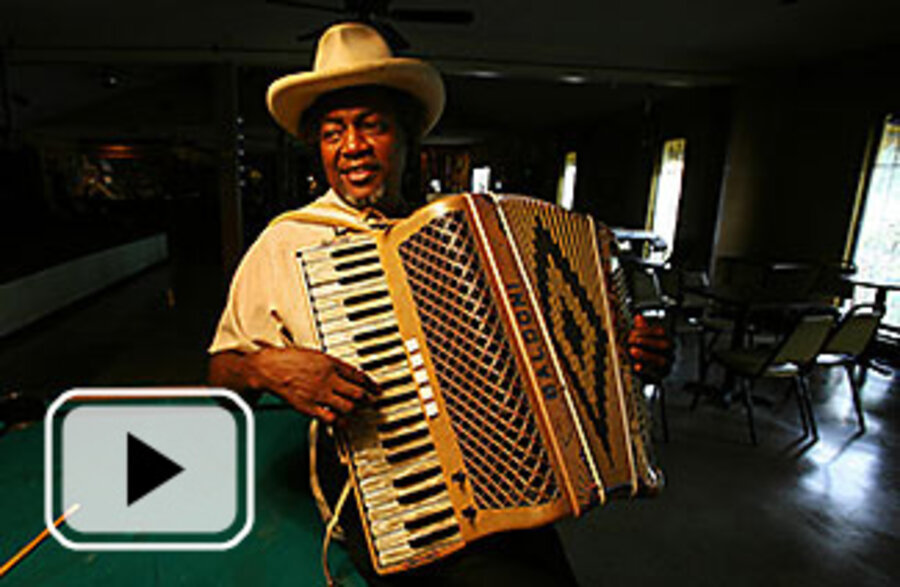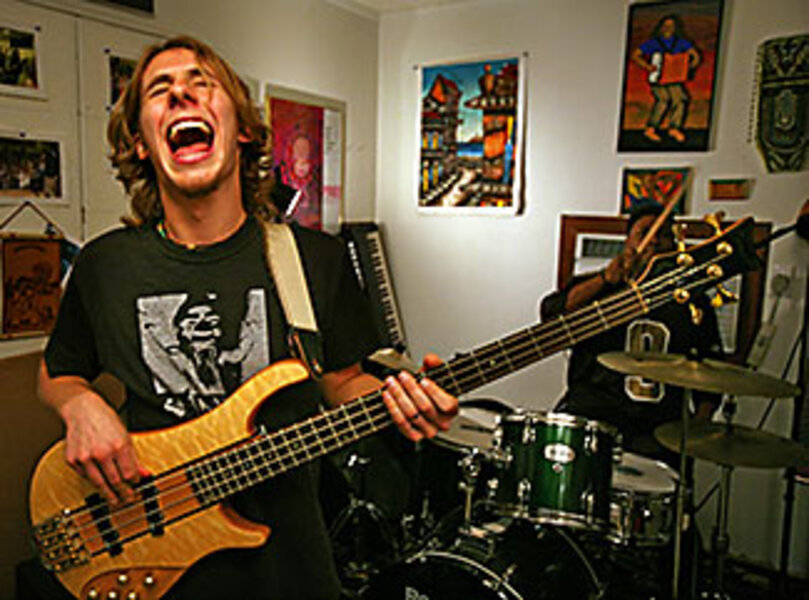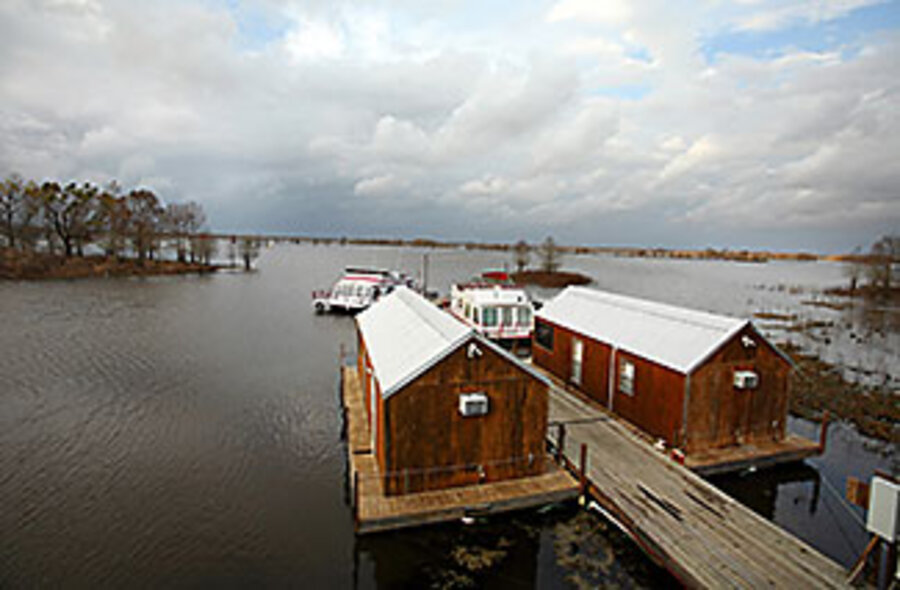At Grammys, zydeco music gets a spark of renewal
Loading...
| Lafayette, La.
When Terrance Simien turned 19, the zydeco musician packed his instruments into a dilapidated van and, along with a bandmate, drove until he arrived at the Lone Star Cafe, on Fifth Avenue, in New York City. The joint was a "dive," he remembers. "Terrible. But it was a popular place to hear music, and we were there to get exposure."
They got it. In the midst of a raucous set of zydeco tunes, Mr. Simien looked out across the audience, and noticed some familiar faces: Paul Simon. Mick Jagger. Bob Dylan. Soon Keith Richards and Ron Wood jumped up on stage, for a jam. "It was surreal, man," Simien grins. "It was a surreal experience. In some ways, it still is."
Despite the occasional foray outside Louisiana, zydeco's roots are deepest in Lafayette, a Southern town perched on the Vermilion River, 130 miles west of New Orleans. Driven by a bustle of accordion and washboard – and soaring French vocals – the folk genre was born here, and perfected by generations of Creole and Cajun musicians.
Some 20 years after his New York debut, Terrance Simien has become Zydeco's modern standard-bearer – and champion for its official recognition at the Grammy awards, which airs Sunday, 8 p.m. on CBS.
In 2001, Simien and his wife, Cynthia, began lobbying the National Academy of Recording Arts and Sciences, which hosts the award ceremony, for a unique category for Cajun and zydeco artists. Back then, musicians in both genres had to compete with mainstream folk recordings – an extremely difficult proposition when the competition is, say, Mr. Dylan.
"It was sort of a revelation one day," says Cynthia, who also acts as Terrance's manager. "So many musicians had passed away without recognition. And there was no way they were going to get recognition under the current system."
Last spring, after years of organizational efforts, Cynthia and Terrance discovered the work had paid off: the academy agreed to create a special category for best zydeco or Cajun album. Additionally, Terrance and his band, the Zydeco Experience, had been nominated for an album called "Live World Wide." On Sunday, Feb. 10, Simien and six other local acts will travel to Los Angeles to participate in the Grammy ceremony. Of the seven nominees, only one is based outside of the greater Lafayette area.
"Zydeco is going through a lot of changes," says Alex Rawls, associate editor at offBeat, a music magazine based in New Orleans. "Terrance is one of the ones who is helping that along – incorporating a lot of other forms, pulling genres together. And what has happened is a real growth of zydeco that has incorporated '80s and '90s R & B, along with blues and rhythms from the Cajun country."
That washboard sound
Contemporary Zydeco was brought to mainstream audiences a half century ago by Clifton Chenier, born in Opelousas, La. Mr. Chenier eventually won a Grammy for his efforts and, before he died in 1987, Zydeco was being popularized by musicians such as Buckwheat Zydeco.
But, the genre purists – and the revolutionaries – are still based in "the heart of Cajun country" amid the ramshackle houses, wandering roads, and shuttered music clubs of outer Lafayette.
"It's in the bloodlines," says Simien. "The music comes from the heart – from experiencing the trials and tribulations of growing up in this area. And you can't fake that. A lot of people want to know about the Creole and Cajun cultures. Well, it's right here, in the music."
Simien was born in 1965 in St. Landry Parish, which rests about 40 miles north of Lafayette, and raised by French-speaking, Creole parents. He first heard zydeco, he remembers, at busy church fundraisers, or community dances, blaring from small, worn speakers.
"Back then," he says, "it was considered music for an older generation. But I pestered my dad to keep taking me to these dances and I found out there was room for kids like me."
In high school, Simien bought a trumpet and, later, picked up the accordion. By the time he hit his early 20s, he was touring on a regular basis, shuttling first to regional concerts and then farther afield, to Boston, to Chicago, to Canada, to New York.
By Simien's rough estimation, he's traveled to dozens of cities and a handful of countries, including Mali, Cuba, and Australia. At his cramped practice space, behind the Simiens' house on the outskirts of Lafayette, concert posters and all-access passes line the walls alongside write-ups from Rolling Stone.
"I've been on stage with some great acts," Simien says, pointing to a photo from the second Clinton inauguration, where his band was invited to play.
Fresh recognition
But after recording a substantial catalog of zydeco records, with a rotating lineup of local musicians, Simien began to turn his eye toward a bigger prize.
"You've got this great overflow of talent," Simien says. "There are zydeco bands all over the world, but right here, within 50 square miles, you've got the world's best. We looked at a way to share a style we can all celebrate."
So, starting in 2001, Cynthia, a trustee of the Memphis chapter of the Recording Academy, kickstarted a campaign to win Grammy recognition for Zydeco musicians. The going was slow. The Academy needs solid numbers before it will consider opening up a new category: records sold, fan base, and a minimum number of albums in that genre.
"We invested hundreds of dollars, and hundreds of hours," says Cynthia, a warm, effusive North Carolina native. "And still, it took a lot of organization – a sort of consistent lobbying effort. You need to lay it all out there.It was an uphill battle."
A trip to the club time forgot
On a warm afternoon last month, Terrance pilots his shiny white tour van out of his driveway toward east, across the center of Lafayette. His destination is El Sido's Zydeco and Blues Club, a small venue that has hosted many of the great Louisiana acts.
The owner, Sidney Williams, is a friend of Terrance's and a mentor to many of the zydeco singers who have passed in and out of Lafayette. He arrived in town years ago as a teenager and made, he says proudly, "$1.09 per hour, washing dishes at the Howard Johnson."
"We weren't big-timers," Mr. Williams smiles. He speaks at a quiet clip, with a thick Southern accent; around him, on the walls of El Sido's, are posters of Chenier, and one – smaller – of Terrance. "But we worked for it. It's the same for Terrance and Cynthia. They worked for it."
These days, the neighborhood surrounding Williams's club is run-down and emptied. Across the street, a few men stand outside a junkyard, watching Williams and Simien emerge from the club. The fortunes of zydeco and Cajun music – distinctly niche genres – have flagged, Williams says, and so has patronage at the club.
Williams attributes the decline to a dilution of zydeco music which has been commandeered, for instance, by rap and R & B artists. (Cupid, an R & B star who attended the University of Louisiana in Lafayette, has been remarkably successful at blending traditional zydeco and Southern rap styles.)
Still, he says, he sees hope in the arrival of the zydeco and Cajun Grammy category, and artists such as Terrance.
"'Cause you know what?" he smiles. "The cream is going to rise to the top."








